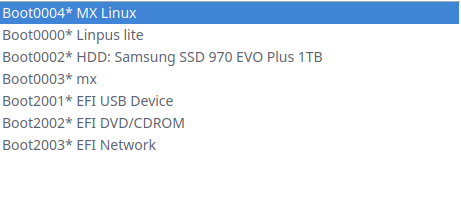I don’t usually post for help mid week, but I am stymied by events since this past weekend with my MX Linux install.
First, last Friday, I made a snapshot of it (took over an hour) and not only saved that to my ext HDD, but put it on its own SSD as it is my daily driver that I depend on.
So over the weekend, I decided to break out an old game manager I had not used for some time and had to modify /etc/security/limits.conf with the following:
username hard nofile 524288Then I had to reboot. When MX loaded the desktop, none of my backgrounds would load, so I looked in file manager and found that none of my ext media was mounted. It has always automounted before.
Then I saw 24 updates. So updated. One was Waterfox, and I had not closed it prior to updating.
After updating, I went back to the game manager and opened it and it was as if I had never done all the work of installing the app needed for one game. It repeated the info that I needed to modify the same security file.
I opened the file and none of my changes remained. So I did it all over again. Then had to reboot.
Again, no desktop images (due to no automount of where they are stored) and my protonmail bridge was “signed out” and that has never happend before. Every reboot, I am auto logged back in so that my email app will work with proton mail.
Then I went back to the game manager, and same thing. Start all over.
But most importantly, 24 updates showed up again. Now memory is not so good, but I swear they were exactly the same as I already did. So this time, took a screenshot. Even used autoremove in terminal to get rid of unneeded packages.
Then I opened up Waterfox (remember that Waterfox was in the updates from v. 6.9 to 6.10) and “about” showed I was still on 6.9. PLUS it opened previous tabs not last open when I exited.
This was getting weird.
Today I opened my Obsidian app to access my business notebook, and it was as if I had just installed it. No notebooks available, it wanted me to create them from sync. No, no, no. My notebooks reside on my internal drive. So I looked. The folders for them were gone. Thankfully, I had just made a “backup” at the end of May because “sync” is not a backup. I usually do this monthly and store it on ext HDD. PLUS I have them on every computer where Obsidian stores your vault locally on that computer.
The backup notebooks remain on that ext HDD. But I do not know what happened to the local copies on my SSD.
Later, 24 updates appeared. I opened the package manager and my screenshot, and they were exactly the same updates, even the same reference to those needing “autoremove.”
So what exactly can be causing this? Surely modifying the security config file would not do all of this? Besides, it does not stick–the change I make after saving are gone after each reboot.
I do not even know where to begin. But I do know that I cannot continue to reboot and have nothing as it was, including signed in accounts, folders missing, updates that did not stick, etc. I even lose all of my history in terminal as there is nothing after reboot.
And just before posting this, I updated for the 4th time, those same updates and yes…they are back.
Sigh…
Sheila
